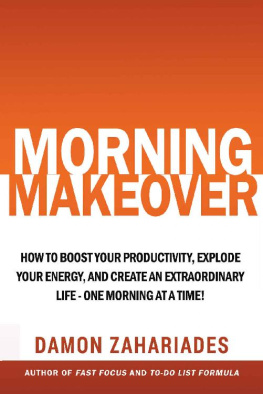All rights reserved. No part of this guide may be reproduced in any form without permission in writing from the publisher except in the case of brief quotations embodied in critical articles or reviews.
The information contained in this book is not designed to replace or take the place of any form of medicine or professional medical advice. The information in this book has been provided for educational and entertainment purposes only.
The information contained in this book has been compiled from sources deemed reliable, and it is accurate to the best of the Authors knowledge; however, the Author cannot guarantee its accuracy and validity and cannot be held liable for any errors or omissions. Changes are periodically made to this book. You must consult your doctor or get professional medical advice before using any of the suggested remedies, techniques, or information in this book.
Upon using the information contained in this book, you agree to hold harmless the Author from and against any damages, costs, and expenses, including any legal fees potentially resulting from the application of any of the information provided by this guide. This disclaimer applies to any damages or injury caused by the use and application, whether directly or indirectly, of any advice or information presented, whether for breach of contract, tort, negligence, personal injury, criminal intent, or under any other cause of action.
You agree to accept all risks of using the information presented inside this book. You need to consult a professional medical practitioner in order to ensure you are able and healthy enough to participate in this program.
INTRODUCTION
It is estimated that around 1.5 billion people around the world live with chronic pain. Often, we ignore the early warning signs of pain, but thats not wise as it can lead to more serious problems down the road. People suffer from a variety of ailments that negatively affect their daily lives, including arthritis, headaches, abdominal pain, back pain, muscle soreness, anxiety, and depression. Suffering from these conditions is completely unnecessary because there may be a simple solution to ease or heal the ailment.
As we age, many of us feel that our health and vitality are slipping away and that we are powerless to stop the seemingly inevitable downward spiral. I was one of those people.
However, I am now a firm believer that it doesnt have to be that way, and Im here to tell you that it doesnt have to be that way for you either. You can choose a different future. A future free from pain and struggle. A future where you feel invigorated and empowered every single day.
Is Cold Exposure the same as Cryotherapy?
The words are often used interchangeably, so I thought it would be a good idea to establish what they mean in the context of this book. Briefly, cryotherapy is any kind of therapy that uses ice or very cold (sometimes extremely cold) temperatures to treat part of your body or your whole body for any particular reason. The reasons we use cryotherapy and the benefits thereof are detailed throughout the book.
Cold exposure, on the other hand, is a relatively new term that refers to a type of cryotherapy that relies less on chambers and gadgets and more on cold showers, ice baths, swimming in icy cold lakes, and walking outside in freezing cold weather wearing nothing more than swimming trunks. Sound crazy? Bear with me. Youre about to learn about the short- and long-term benefits of cold exposure and cryotherapy in a way that I hope will convince you to give it a try.
In essence, both cryotherapy and cold exposure expose your body to extremely cold temperatures for short periods of time. They both work at a cellular level to accelerate recovery. The extreme cold temperatures improve blood circulation, speeding up the removal of toxins. The oxygen and nutrient-rich blood flow also improves organ function while reducing inflammation. Most notably, the extreme cold stimulates skin sensors, causing the release of endorphins, the bodys natural pain inhibitors and mood elevators.
Cold exposure has been a daily practice for professional sports teams and athletes like Lebron James, Cristiano Ronaldo, Allyson Felix, and Novak Djokovic for many years. Post-exercise cold exposure treatment sessions help sportspeople ease muscle tension, rapidly accelerating recovery, and decreasing the effect of delayed onset muscle soreness (DOMS). A-list celebrities like Tony Robbins, Will Smith, Lady Gaga, Jennifer Aniston, Kevin Hart, and countless others are also firm believers in the powerful benefits of cryotherapy.
You will probably be surprised to know that these celebrities also keep themselves looking youthful with the help of cryotherapy. Cryotherapy is a relatively low-cost wellness treatment that promises everything, from healing chronic sports injuries and improving your state of mind to reducing anxiety and prolonging your life. The great news is that you dont have to be rich and famous to benefit from it because cold exposure does the same at no cost. Cold exposure, also referred to as cold therapy, can help anybody, even those who dont have the budget to pay for cryotherapy sessions.
Despite cryotherapy being an ancient form of healing, I dont believe it has had the recognition it deserves. Because cold water is relatively inexpensive to access for most people, corporations have no financial incentive to promote it, unlike the big pharma companies that make billions every year from selling drugs.
No one exemplifies the cold therapy movement better than the Dutch guru Wim Hof, whose remarkable ability to regulate his body heat in the extreme cold has sparked intense scientific study and earned him the name The Iceman. Thanks to Hof, scientists in the US and Europe are starting to better understand how cold adaptation might help combat autoimmune diseases and chronic pain.
Personally, cryotherapy has changed my life for the better. In my early 20s, I was a semi-professional athlete. As a sportsman, I always strived to improve my mental and physical performance. But, at the age of twenty-five, I suffered a severe eye injury and was forced to retire. The ophthalmologist told me that I would never be able to play the sport I loved again. That was a difficult message to comprehend. My whole identity was wrapped up in being a sportsman. To have that taken away prematurely was a bitter pill to swallow.
The few months following my retirement from sport were particularly difficult. I developed back pain, joint stiffness, anxiety, lethargy, and weight gain due to a lack of physical activity and poor eating habits. My health was spiraling out of control. Prescription medicines only temporarily masked my pain, my sleep patterns were erratic, and my energy levels and motivation were at an all-time low.





